Regina Luz Jordan sits down with designer Hope Johnstun for an unflinching, exclusive interview with Hollywoodland News, about her years at Pinup Girl Clothing—and what really went down behind the seams with owner Laura Byrnes.
I’ve been collecting receipts like they’re ration stamps during wartime—and let me tell you, the stockpile is heavy. Since February, the inbox has been flooded with whispers, warnings, and “you didn’t hear it from me but…” messages. This isn’t gossip. It’s a reckoning.
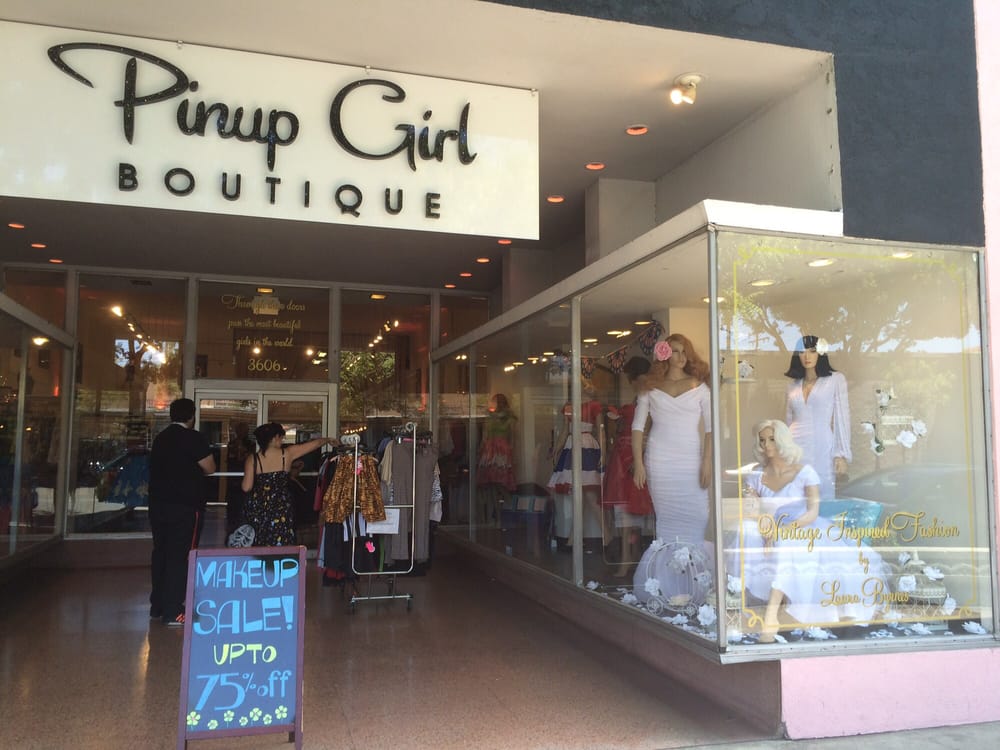
When a brand builds its empire on empowerment and leaves a trail of unpaid women in its wake, you don’t stay quiet. You show up with a flashlight and a filing cabinet.
Call it what you want—accountability, investigation, hell, even a little righteous rage—but make no mistake: we’re telling the truth out loud. And if the truth makes “some” people uncomfortable? Good.

So when I opened my DMs and saw Hope Johnstun’s name, I knew we were finally going there. The slow, messy collapse of Pinup Girl Clothing wasn’t just a fashion industry footnote—it was a masterclass in how not to treat the very women who made you matter.
Hope didn’t go quiet. She waited. And now she’s ready.
What finally pushed her to speak? “The promotion of new items in the Pin Up Girl Clothing Facebook group spurred me to speak out publicly,” she said. After years of trying to make it work behind the scenes, that moment broke the dam.
Before Hope: A Carefully Crafted Exit
Before Hope ever entered the picture, the cracks in Pinup Girl Clothing’s foundation were already showing.
In 2019, Laura Byrnes, the founder of PUG, released a video statement in the Pinup Girl Customer Lounge on Facebook. She announced her retirement, citing burnout, health, bullies and the evolving fashion industry as her reasons for stepping away, “I’m so proud of everything we’ve built, but it’s time for me to step away and focus on my health and my family,” Byrnes said. “The industry has changed, and I no longer feel like PUG is where my heart is.”

She closed the video with a line that raised more than a few eyebrows: “I get to fucking retire and be very comfortable for the rest of my life at age 50.”
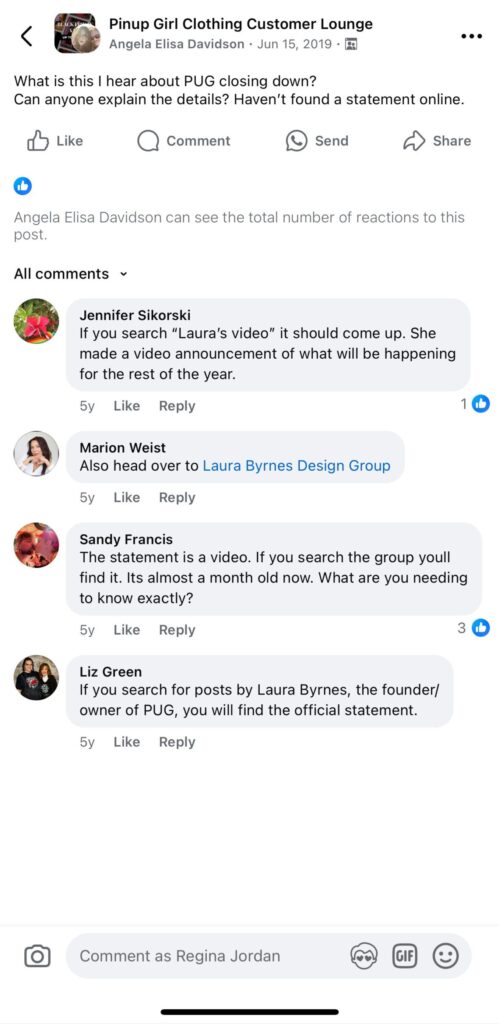
But not everyone bought the fairytale ending. Behind the scenes, things were unraveling fast. The company was deeply in debt. Employees were on 1099 contracts, making less than $24 an hour with no health benefits. Designers and vendors were going unpaid. Customers were complaining about late orders and radio silence from customer service.
The so-called retirement? It wasn’t the graceful exit of a founder closing a beloved chapter. It was a narrative pivot. A cover story for collapse.
And the gaslighting wasn’t limited to financial realities. Byrnes often framed criticism as cruelty, casting herself as a victim of online bullying rather than a business owner responsible for her company’s failures. Anyone who questioned her narrative was blocked or booted from the Facebook group. Dissent disappeared overnight.
This was the environment Hope Johnstun walked into in early 2020.
“She had everyone fooled, even me. We had been planning our collaboration already for almost a year.”
She didn’t sign up to save a sinking ship—but once she was on board, that’s exactly what she ended up trying to do.
Textiles, Tech Packs, and Total Takeover
Hope Johnstun didn’t walk into Pinup Girl Clothing expecting to be the last woman standing—but by the time she left, that’s exactly what it felt like. Let’s be clear that before the contract, before the drama, Hope and Laura were friends so a mutual respect and trust were already established.
They took that friendship and began a working relationship that started with a contract. “Initially, I began working with Laura via a contract for textile design,” Hope said. “We put out the first collection from this collaboration beginning in January of 2020—bad timing.”

This wasn’t just artistic flair—her work brought serious revenue. “My designs were directly responsible for 10.5% in 2020 and grew to at least 25% of tthe profits in 2021. In 2022, the profits shrunk but my designs were still responsible for a quarter of the profits.”
Let that sink in because designing prints? That was just her warm-up act.
Hope took on more roles than a one-woman theater troupe—without ever being brought on as a formal employee. “I began sometime in mid-2020 doing work on the back end of the site—things like uploading new images, editing images, writing copy for products, and merchandising pages,” she said. Then it snowballed. “I started to take on more responsibility, running the social media, connecting with influencers, and taking over purchasing for shoes and accessories. Purchasing included collaboration with small jewelry and accessory artists, buying from wholesalers, and attending trade shows.”
But that didn’t come without a punch to the gut, “I was told to post my face more when representing the brand because I gave legitimacy to the plus size clothing.”
Let that sink in for your empowerment moment brought to you by the letters F & U.
And then came the LA photo shoot.

In July 2020, she flew to Los Angeles for a shoot. “I flew to LA for a shoot to do the styling and ended up being the photographer,” she said. “After that point I was the default photographer and the point person who organized all of the photo shoots—this entails choosing the stock items that got shot with any new items that needed pictures, booking models, hair/makeup/stylists, coming up with shoot concepts, booking locations, and coordinating with the warehouse to check all the products out for a shoot and back into the shoot closet. I was also creating and editing all of the media for the website, socials, and emails.”
By May 2021, she had gone all in. “I left my full-time job and was working only for PUG with a title of something like Project Manager,” she said. “I’m not sure exactly when everyone began referring to me as the Creative Director… but that was my title for around the last year and a half of when I was there.”
And that “Creative Director” role? It wasn’t a vanity title. It was full throttle. “I was doing all the work of communicating with the production department to get products launched—creating tech packs, choosing solid colors to go with prints, checking in to ensure timelines were being met, etc. I also did some garment design in the form of sketching, and the production department created the samples and patterns from there. With approvals from the company owner, I was planning collections by picking the styles that would be produced in each print and solid.”
Hope didn’t just manage; she also scouted talent. “I often head-hunted textile designers, and when their designs were purchased by PUG, I was the point of communication with them to relay any edits,” she explained.
She was also managing social content and community interactions. “I was also planning, promoting, and running sales, which included answering all customer questions on behalf of the company in the Facebook group and on Instagram and TikTok. I was in charge of the company’s relationship with influencers and set up the affiliate program.”
“I know some of the affiliates were having late payments for their links, and there are a few people who had been working with the company pretty regularly through the time that I was there who decided that they were not interested in working with the company anymore.”
Oh, and she organized two full-scale international photo shoots. “I coordinated them by booking the models, arranging everyone’s flights, booking hotels and transportation, overseeing the sample timeline to make sure we had what we needed to shoot before leaving, planning out each shoot day, and doing the photography and styling.”
Two expensive international photo shoots while customers were loudly questioning where their refunds were, why affiliate payouts were late, and how packages kept disappearing. The disconnect was wild. Glossy marketing, high-end shoots. And for Hope, all of this while being paid as a 1099 contractor—no benefits, no PTO, no insurance.
“I was working 45 to 50 hour weeks for months at a timebut I was only approved for for 39 hours regardless of how many hours I actually worked,” but that wasn’t all, “I worked through every vacation while I was a 1099 contractor, even my honeymoon.”
She wasn’t the only one doing the work. But she was doing more of it than most—and doing it all while carrying the title of contractor, not employee. No benefits. No protections. No credit.
“Let me be clear—this list is not exhaustive, and it is cumulative,” Hope said. “At no point were any of the responsibilities removed from what I was expected to do.”
She didn’t clock out—because she was never allowed to clock in.
The Burden of Belief
“The work culture was high-pressure,” Hope told me—measured, not dramatic. She’s careful in how she tells her story. She’s not here to light a match just to watch it burn. She’s not here to torch people for sport. She praises her coworkers. She gives credit where it’s due.
“There were people there who were really good at their jobs, and I loved working with them. That part of it—I really miss.”

But what happens when you keep showing up, doing everything that’s asked, and still get left behind? It wasn’t just the workload. It was the promises. Promises that never made it past someone’s outbox.
And the silence? Deafening.
“The owner would often disappear for weeks or months at a time, and then come back and be upset that things weren’t being done the way she wanted—even though she hadn’t communicated what she wanted.”
Still, Hope stayed. She kept the trains running. She handled the chaos,
When I asked Hope if there were red flags around money at PUG, she didn’t elaborate. She didn’t have to.
“Yes.”
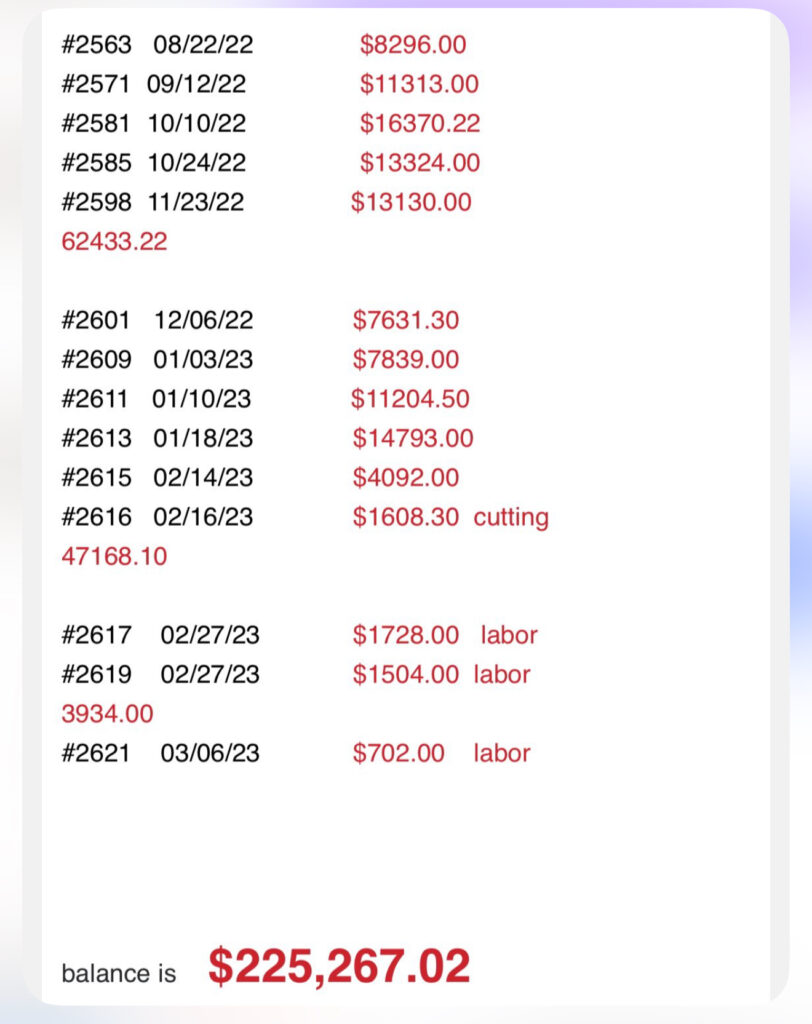
An actual financial record sent to me from an anonymous source
That one word landed like a dropped hammer. A thousand bounced checks, misdirected invoices, and ghosted payment emails in a single syllable. Some people were paid weekly. Others were told to wait. Some didn’t even get an invoice—just vibes and hope.
While Hope was trying to hold the brand together with the barest scraps of structure, the company was still bleeding credibility from wounds it refused to treat because by the time Hope came in the door in 2020, people in the vintage world were already whispering about what had gone down with Micheline Pitt. The 2017 lawsuit? Public record. The copyright drama? Known. The non-disparagement agreement? Broken. The Instagram comments? Gone—scrubbed clean like it never happened. But everyone knew.
Hope didn’t come for the drama. She came to work for her dream job. But the tension was already in the air. While she says she was never asked to copy Micheline’s work, Hope could see what was going on.
Because here’s the truth: this wasn’t some fluke. This was a pattern.
Hope was part of a long line of creatives who gave their time, their talent, their vision—and walked away burned. There were exits that never got announced. Collabs that vanished overnight. Stories that got buried. Lawsuits that quietly disappeared.
The message was always the same: you are replaceable, but your work is not.
And that’s what makes it hurt.
Legal Echoes and Old Wounds
By the time Hope was buried under unpaid invoices and overflowing task lists, the foundation was already cracked.
Let’s rewind to 2021—the year the glossy veneer of Pinup Girl Clothing started to crumble in public.
That year, a temporary restraining order was issued against founder Laura Byrnes for violating a non-disparagement clause in a legal settlement with former designer Micheline Pitt. The original lawsuit? It wasn’t some petty spat—it was about copyright infringement and the unauthorized use of Pitt’s designs and images after she left the brand.
It was public. It was ugly. And it was one of the first undeniable signs that behind the branding, something was seriously broken.
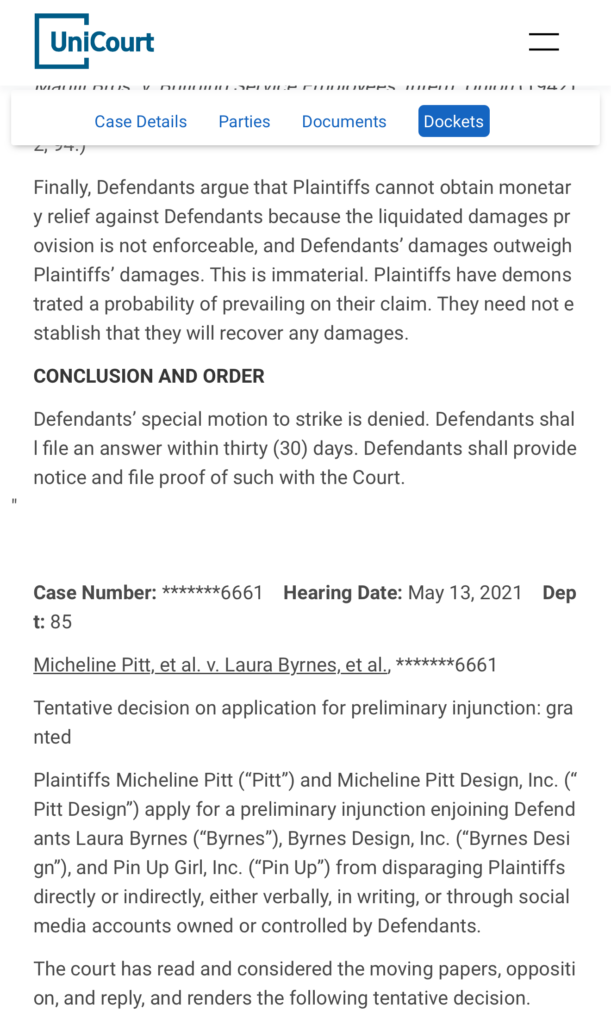
In court, Byrnes first tried to claim she was the one being bullied and when the court asked her for her proof to counteract Pitt’s 37 exhibits of documented harassment, she had nothing. When that defense didn’t work, Laura Byrnes’ tried to argue that her First Amendment rights were being violated. Bu t t he judge explained that’s not how a disparagement clause works. The judge didn’t hold back either—telling both women that there was a clear pattern of harassment and abuse. Micheline was then granted the restraining order and public records now show Laura Byrnes was the mean girl in all of this, alongside those 37 exhibits that paint the full picture.
- Byrnes spent years engaging in targeted online harassment.
- She was caught.
- She suffered the legal consequences.
When I asked Hope about that time, she didn’t speculate. She didn’t drag anyone. But she didn’t lie either.
“The owner of the company stated to several people that it was worth breaking their non-disparagement clause because they believed that they were standing up to a bully.”
Let that sink in: they broke a legal agreement—on purpose—and tried to spin it as some twisted form of empowerment. That’s not hearsay. That’s what was said, loud enough for others to hear and remember.
And while the court case unfolded, so did the customer complaints.

By mid-2021, Trustpilot reviews started rolling in like tidewater—slow at first, then flooding the shore. Customers were furious. Some couldn’t get a refund. Others received the wrong items. One reviewer wrote:
“Honestly dealing with them has been an absolute nightmare!!! They sent the wrong item that was ripped up and f***ed up.”
Another was still waiting for a refund after more than a month:
“I am still waiting for my refund for the out of stock item that I had ordered over one month ago”

Meanwhile, behind the scenes, Hope was still running full-speed toward a cliff she didn’t know was coming.
What she didn’t know was that the company was legally suspended in the state of California—for failing to pay the California Franchise Tax Board.
Let me repeat that: The business was not legally allowed to operate.
But it kept selling anyway. Kept showing up at events. Kept smiling for the camera like nothing was wrong.
And when the main site started to fade into the background, what did Laura Byrnes do? She moved operations over to her personal website—Laura Byrnes Designs—and quietly continued selling remaining PUG inventory through what amounts to a grey goods loophole. No announcement. No explanation. Just business as usual tied up with a bow as a special sale until nature said nah.
Because eventually, even the universe got tired of the charade.
By 2023, with mounting legal fees, a tarnished reputation, and a business that had lost its core customer base, Laura Byrnes was at a precipice.
In January 2025, the Altadena fires tore through Los Angeles, taking out what was left of PUG’s warehouse stock—inventory that, according to multiple accounts, had been moved into Laura’s basement after she allegedly stopped paying the warehouse provider.
The comeback era?
Literally went up in flames but a rebrand had already been set in motion for what could only be described as a quiet reincarnation, unfolding in public record. In September 2024, a brand-new business entity—Pinupgirl Creative, Inc.—was registered in New York. Different name. Different location. Different contact. Same old story.

Customers were told that this was a sale of the Intellectual Property but public records still show Laura Byrnes as the CEO.
But for Hope?
“Exhausting.”
And through it all, the company kept spinning the same tired story “Everything’s fine. We’re back. We care about women.”
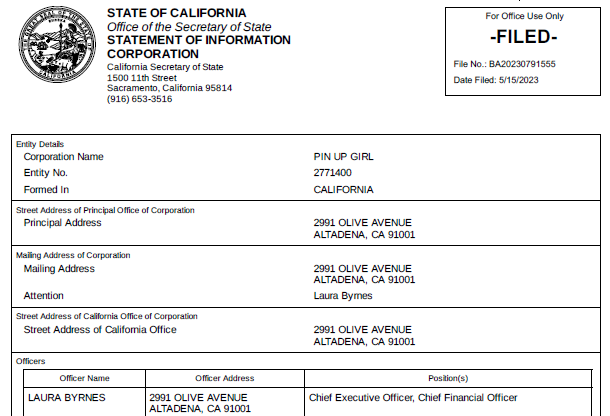
But the reality? Quiet restructuring because this beautiful legacy brand that fans had come to admire and were committed to supporting was falling apart behind a curated grid of pretty pictures.
And Hope? She was still not paid.
Financial Smoke and Mirrors
Hope Johnstun’s own payments stopped altogether after Spring 2022. And the silence that followed? It wasn’t accidental. It was strategic.
And when she asked for the money she was owed?
“I sent what was not the first email to the accounting department with just truly asking if there was a way we could set up some kind of payment plan for what was owed to me for designs… I was like, well, I’m not comfortable with you producing more until I’m paid.”
She wasn’t just chasing money. Hope Johnstun was trying to prevent further exploitation of her art. She doesn’t name names. She doesn’t need to. The pattern speaks for itself.
“I have tried for years to go about getting paid via the route laid out in my design contract,” she told me. “I gave the company many chances to pay me in installments, and attempted arbitration and mediation, but have had no luck getting the company to come to the table.”
A few months before she left, Johnstun was told she’d be expected to take over production management—on top of her creative direction—despite living across the country in New York. When she pushed back and asked to set up a payment plan for the money she was owed, she was met with silence.
What she got instead was a text—on her husband’s birthday. At 9:30 p.m.
“I had taken the day off because it was my husband’s birthday… and I got a message saying they could no longer afford to pay me hourly and pay off the debt they owed me. So they would no longer be needing me for hourly work.”
The company said they’d start paying back what they owed her in weekly installments. That lasted a few months. According to Hope, most of Q1 2022 was eventually paid—but by Q2?
“Payments stopped without any kind of warning.”
By June 2023, Hope was still owed approximately $25,000.
“When I asked for payment for my designs, I was told that the company couldn’t afford to pay me—but then they would go and hire new people or buy new equipment or do other things that showed that they did have money.”
She had documentation. All of it.
“I have documentation of all of the designs that I created, all of the work that I did, all of the promises that were made to me, and all of the ways in which those promises were broken.”
Despite everything, she didn’t immediately pursue legal action. She gave them time. She gave them grace.

“The reason it has been years is because I was not interested in pursuing like harsh legal action, like a lawsuit, because I wanted to give the company grace to do as they said they would and pay me—and that is just not how it turned out.”
She attempted arbitration, as laid out in her contract. She hired a lawyer. She waited. The company never responded.
And arbitration? That route hit wall after wall. “We never heard anything back from them—not from the company, not from the arbitrator,”
This wasn’t chump change. This was survival money. Rent money. Food money. The kind of money most women creatives are never encouraged to fight for.
“That’s a lot of money for someone like me,” she said. “I don’t come from a family with money. I’ve never worked a job that paid more than $45k a year.”

And in the months after being let go, she had to make impossible choices just to stay afloat. By then, Hope was out of work. She had no severance. No benefits. No resolution. So she did what she had to do.
“I ended up having to sell the majority of my collection of clothes to pay my bills. And these are like the pieces that I designed—stuff that I will never get back.”
Let that land.
She had to sell the literal clothes off her back. The garments she spent years creating. The ones that once symbolized her success, now sacrificed just to survive.
Sketches, Silence, and the Final Straw
Even after being let go, Hope tried to move on with dignity.
But in 2025, she logged onto Facebook and saw something that stopped her cold: new products being promoted in the Pinup Girl Clothing group.
New collections. New prints.
“In the Pin Up Girl Clothing Facebook group, they, for the first time, have been promoting new items coming out of production. And so while I was there, part of my role was to draw sketches of the styles of dresses that exist or that were coming soon.”

Those sketches—drawn by Hope—were being used to advertise upcoming launches. That wasn’t just a slap in the face. That was a message.
A reminder of just how disposable creatives become when a company decides their work matters more than their name.

Hope explained that during her time at the company, she drew sketches of dress styles that were used internally to test how prints would scale on garments—and externally for pre-release promotional materials. Those illustrations were hers, not the company’s. Hope didn’t want to be here. But when the company started using her unpaid labor to sell empowerment?
“The drawings themselves of the dresses I drew, and those are mine, because I was not an employee… so it is not illegal that they use them for promotion of new products, but it’s honestly a bit of a slap in the face, as they are not paying me for what they owe me.”
It wasn’t just the use of her illustrations. It was what they were attached to.
“One of the new prints they are promoting is major elements from a design that I drew called Capri Floral, which we produced several color versions of under our collaboration. It has been taken and just kind of rearranged.”
It wasn’t inspiration. It was reuse. And it was personal.

She continued: “It’s one of my favorite pieces, and I gave myself a migraine drawing it. It’s so detailed. From a legal standpoint, you only have to change something 20%—then you can do whatever you want with it. But to take something that I hand drew, that is something I really love … It’s so detailed. But to take that and use it to make more money, when, again, they still have not paid me—hurtful.”
They weren’t just using her work.
They were building new products on her back while still owing her $25,000.
“The fact that they’re now using my designs to promote new products without paying me or giving me credit is just adding insult to injury.”

And it wasn’t the only promise broken.
That’s the part no one sees—the part that doesn’t fit in a press release or a curated Instagram caption. This isn’t just a story about unpaid labor. It’s about emotional exhaustion. It’s about how many times you can be told “we care about women” by people who treat your work like it’s disposable.
And through it all, Hope stayed silent.
Until she couldn’t anymore.
She’s not exaggerating the impact.
“It’s so weird and uncomfortable and embarrassing, and I hate it.”
This wasn’t a brand anymore. It was a broken promise on repeat. And finally, Hope decided to say what no one else would:
Enough.

Hope Johnstun & Pinup Girl Clothing:
Legacy vs. Lip Service
In an industry that loves to scream empowerment from the rooftops, Hope Johnston keeps it simple:
“If a company claims to be here for female empowerment and to support women, it should pay women who work for them.”
Period. No hashtags. No hollow branding. Just the truth.
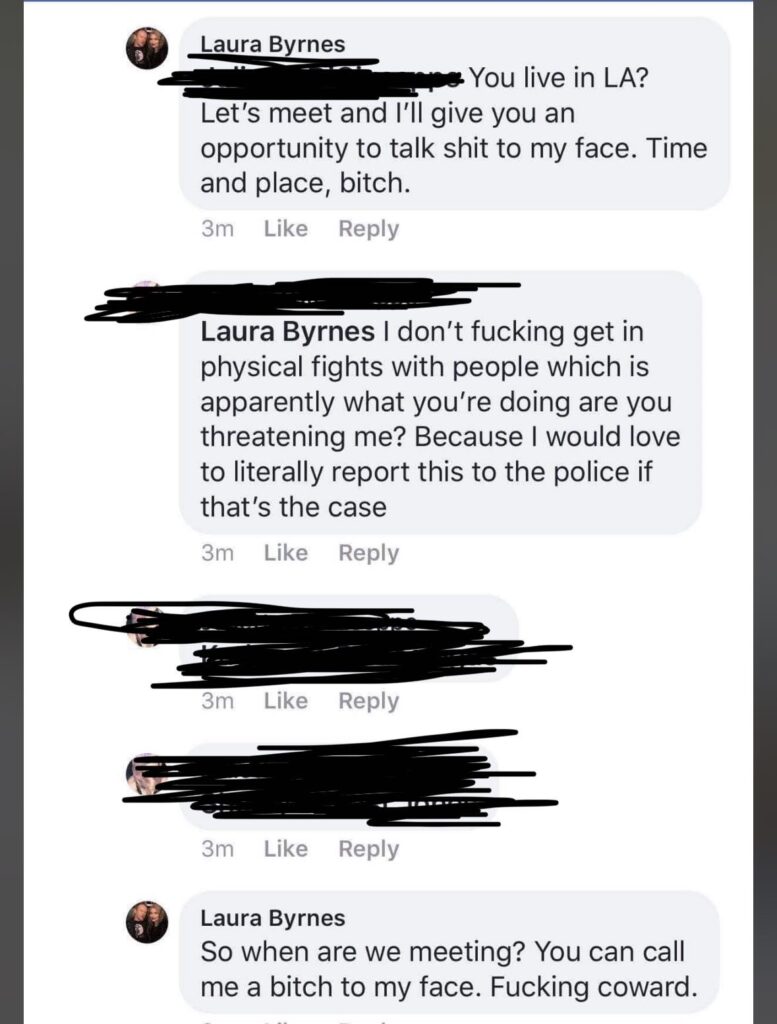
She’s not alone. Others have come forward with similar stories—missed paychecks, ghosted collaborations, bounced affiliate payouts. FedEx bills that went unpaid. Wholesale partners left in the dust. Fabric vendors lining up with lawsuits. Customers confused and fed up. A whole chorus of people left behind while the company smiled for Instagram, an account now run by the owner’s eldest daughter. I know this because I have the stories shared with me by people who choose to stay anonymous.
This isn’t just about one woman. This is about a pattern. And that pattern has a paper trail. Hope’s not bitter. She’s just done. She gave this company her art, her time, her heart—and when the lights went out, she was still standing there, holding the weight of it all.
“It’s a real bummer the way it ended,” she told me. “I loved so much of what I got to do. Seeing people in things I designed is my favorite thing in the world. It brings me so much joy.”
And that’s what makes it sting. Because she still believes in the work. She still believes in empowering women through style.
But belief doesn’t pay the bills. And love doesn’t cancel debt.
She’s not asking for pity.

She’s asking for accountability.
And while Pinup Girl Clothing never gave her that…
She’s giving us something they never could:
Closure.
what is Pinup Girl Clothing’s true legacy?

Hope shares with me, “It’s not right that for several years, they have been selling products, and instead of taking the percentage out of each sale and giving it to the person who they signed a contract with who designed that thing, they just have kept all of the money.”
And that’s the only brand message that matters.
This isn’t about cancel culture. It’s about consequences.
Because while the brand once claimed to be built on sisterhood and style, what was left in its wake was something else entirely. There’s the more than one million dollars in mounting debt and lawsuits piling up like abandoned shopping carts. There are the employees—contractors, creatives, warehouse staff—still chasing down wages they earned but never received. There are customers forced to file claims with their credit card companies just to get back the money they paid for dresses that never shipped. And then there’s the absolute gut punch of watching those same dresses—or knockoffs indistinguishable from them—surface on AliExpress for five bucks, thanks to a reverse image search.
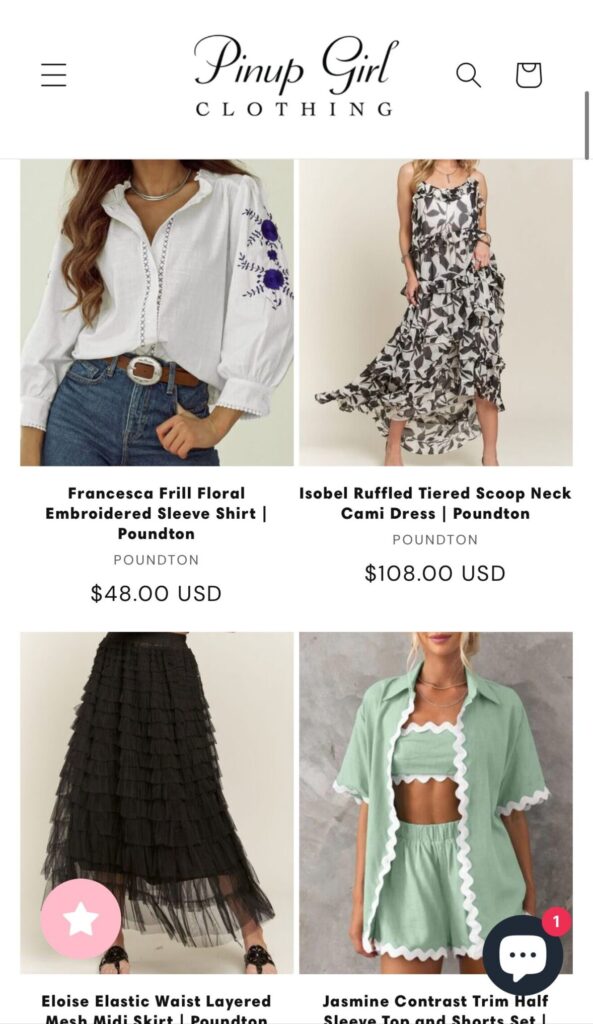
The brand may have spent years curating the aesthetic of empowerment, but behind the filtered photos and carefully worded captions was a business running on fumes—and on the unpaid labor of women like Hope Johnstun.
Meanwhile, Laura Byrnes is sipping wine in Italy, posting real estate listings on TikTok.
EDITOR’S NOTE: This story is built from interviews, verified documentation, public records, and direct quotes. Allegations reflect the experiences of those interviewed and are backed by either court filings, contracts, or communications provided to Hollywoodland News. All efforts were made to verify accuracy, and we remain committed to truth, transparency, and accountability.
We’re not here to cancel. We’re here to connect the dots and say the quiet parts out loud.
If you have a story to share about this brand and want to tell your story, reach out to regina@hollywoodlandnews.com



Leave a Reply